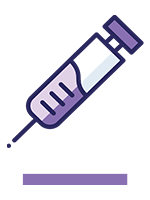Your dog has been diagnosed with a mast cell tumor, and your veterinarian has prescribed STELFONTA. On this page, you will find information about the treatment process, pretreatment preparation and how to care for your dog afterward.
Remember, always speak with your veterinarian if you have any questions about your dog’s treatment.

Described and pictured below is the healing process for a typical mast cell tumor—the treatment of some tumors can result in a greater amount of swelling, bruising and a larger wound that may need additional attention and a longer time to heal. Please note these photos are for reference only.
It's important to understand what to expect at each of the four stages of treatment and the potential side effects, some of which can be serious.

Pretreatment involves oral medications, including corticosteroids and antihistamines, prior to the injection of STELFONTA. These medications are very important to reduce the risks associated with inflammatory substances that can be released from the tumor as the mast cells are destroyed.
Premedication is given 2 days pretreatment and continues until 7 days posttreatment. It is essential that you give all medications as prescribed.

• Tell your veterinarian about:
- Any and all medications your dog is taking
- Your dog’s previous or current medical conditions
- If your dog is pregnant, nursing, or if you intend to breed your dog
• Give all medications as prescribed by your veterinarian

At the veterinary hospital, your veterinarian will inject STELFONTA directly into the tumor.
Most dogs do not need sedation or anesthesia during the procedure although occasionally, dogs may be sedated.
Side effects reported in dogs treated with STELFONTA were generally mild and short lasting, but they can be severe, especially if not treated in a timely manner.
The most common adverse reactions included wound formation, injection-site pain, lameness in the treated limb, vomiting, diarrhea, and hypoalbuminemia (low levels in the blood of the protein albumin).
Although most side effects/adverse reactions seen in clinical studies were mild, the most serious side effects occurred in the first 4 days. Excessive pain, lameness, tiredness, refusal to eat for more than one day, repeated vomiting or diarrhea, trouble breathing, changes to the treated tumor site (including increased or excessive swelling and bruising, extensive wound formation, increased irritation) or any other symptoms should be examined immediately and treated accordingly.


• Changes in color of tumor
• Possible pain, swelling, and bruising at treated tumor site
Bruising or swelling may appear at the treated tumor site, possibly lasting for several days and could cause your dog some discomfort. Talk with your veterinarian about pain control for your pet.
The treated tumor site may blacken and leak some fluid for a few days.
A reddish “pocket” or wound will form, which allows healthy new skin to grow.
An odor may be given off from the treated tumor site.




• Keep wound clean and uncovered. To clean site, use warm water and wear disposable gloves
• Pain medication may be prescribed to relieve discomfort
• Make sure your dog has access to drinking water after treatment
• As the wound may leak on furnishings and clothing, protect surfaces and keep your dog in a limited area in your home during the first few days

During this stage:
Healthy new skin grows, closing over the wound. Skin returns to its original color and hair typically regrows.
Your veterinarian will schedule regular follow-up visits. In some cases, a second injection may be needed if your dog’s tumor has not been completely removed.
Contact your veterinarian right away if:
Contact your veterinarian if you notice excessive pain, increased or excessive swelling and bruising, extensive wound formation or other clinical signs are observed.


STELFONTA removes 75% of canine Mast Cell Tumors with a single treatment1
88% of dogs had a complete response* after either one or two treatments combined**
* Complete response was defined as complete removal of the tumor.1
** Results from pivotal field efficacy study: 70/80 dogs achieved a complete response at 28 days after one or two treatments of STELFONTA®.
1. De Ridder, TR, Campbell, JE, Burke-Schwarz, C, et al. Randomized controlled clinical study evaluating the efficacy and safety of intratumoral treatment of canine mast cell tumors with tigilanol tiglate (EBC-46). J Vet Intern Med. 2021; 35: 415– 429. https://doi.org/10.1111/jvim.15806
There can be some discomfort during the tumor breakdown stage (Stage 2 and 3). Your veterinarian can prescribe pain medication to help your dog through this period if needed.
STELFONTA may cause side effects, even at the prescribed dose. These side effects include, but are not limited to:
Contact your veterinarian if you notice any of the following changes in your dog:
You can walk your dog outside as normal, even with the open wound. Walking will help circulation and the healing process.
Some discharge from the treated tumor site following treatment is expected. The treated tumor site can be cleaned with warm water as necessary. Wear disposable gloves when cleaning the treated tumor site.
Wear disposable gloves when cleaning the treated tumor site to avoid contact with any residual drug. Thoroughly wash your skin that comes in contact with the treated tumor site, wound, or wound discharge. Ensure your dog receives their prescribed medications to decrease the potential for severe, life-threatening adverse reactions. Monitor your dog during the healing process and contact your veterinarian if you notice excessive pain, lameness, tiredness, refusal to eat for more than one day, repeated vomiting or diarrhea, trouble breathing, changes to the treated tumor site (including increased or excessive swelling and bruising, extensive wound formation, increased irritation) or any other symptoms that concern you.
Your veterinarian can contact Virbac Veterinary Technical Support at 1.800.338.3659 to report adverse events, obtain case consultation or more information about this drug.
©️ 2021 Virbac Corporation. All Rights Reserved. STELFONTA is a registered trademark of QBiotics Pty Ltd, used under license.
Call us if you have any questions about your dog's treatment